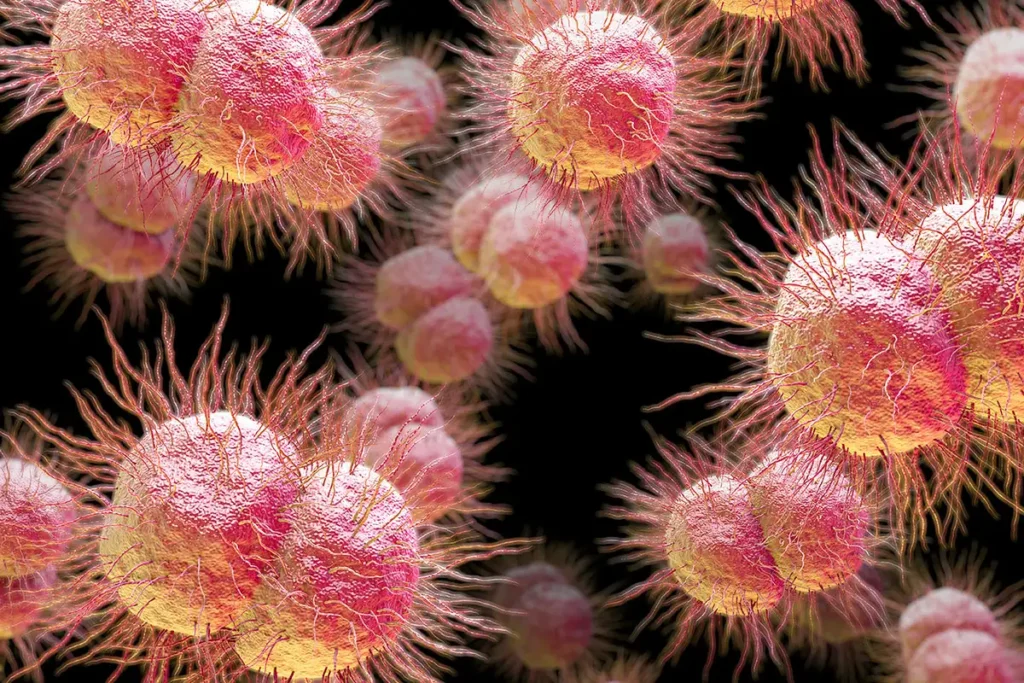
Medorrhinum
Latin name: Medorrhinum
Short name: Med
Common name: Gonorrhoeal Virus | Sycosis nosode | Gonorrhoeal poison | Medorrhinum nosode | Discharge of Gonorrhoea
Primary miasm: Sycotic Secondary miasm(s): Syphilitic
Kingdom: Nosodes
Family: Pathological discharge
- Symptomatology
- Remedy Information
- Differentiation & Application
Prepared from the urethral discharge of a patient with gonorrhoea. A nosode remedy deeply linked to the sycotic miasm, chronic inflammation, and inherited predisposition.
None in conventional medicine; used exclusively in homeopathy as a nosode for deep chronic states.
Originally proved by Dr. J. C. Burnett, then extensively clinically observed by Dr. J. H. Clarke, Margaret Tyler, and others
- Pelvic and urogenital organs (prostate, ovaries, uterus, urethra)
- Nervous system (especially peripheral nerves and sensorium)
- Mucous membranes (inflammation, overgrowth, discharge)
- Mind and emotions (guilt, secrecy, wildness)
- Spine and extremities (tenderness, burning, restlessness)
- Lying on the abdomen
- At the seaside
- Night air
- Hard pressure
- Cold bathing
- Bending backwards
- Loosening clothes
- Daytime (many symptoms improve at night)
- Heat, sun, and warm rooms
- Damp weather
- Touch
- Fatigue
- Sexual excess or suppression
- Thinking of symptoms
- Thuja – Also sycotic, but more fixed ideas, warts, and coldness; Medorrhinum is more restless and wild
- Sulphur – Restlessness and burning feet shared, but Sulphur is more philosophical, ragged, hot-headed
- Lachesis – Talkative, passionate, and left-sided, but Lachesis worsens at night; Medorrhinum improves at night
- Pulsatilla – Soft, yielding, < heat, > open air; Medorrhinum has more aggression, secrecy, and intensity
- Tuberculinum – Restlessness and inherited miasm, but Tub has desire to roam and travel, Medorrhinum is more guilty and sexual
- Complementary: Natrum sulph., Thuja, Syphilinum
- Antidotes: Pulsatilla, Nit-ac., Thuja
- Follows well: Thuja, Sulphur
- Precedes well: Carcinosinum, Tuberculinum
Medorrhinum is the embodiment of suppressed vitality, the deep shadow of the sycotic miasm. It often appears where disease has been repeatedly suppressed, especially in the generative sphere or mucous membranes. The patient is impulsive, restless, and tormented—longing for stimulation, freedom, and release. Whether the suppression is emotional, physical, or inherited, Medorrhinum helps bring it to the surface and transform it. It is the remedy of paradox and extremes—great energy yet deep exhaustion, excessive passion followed by detachment, clarity alternating with confusion.
- Powerful nosode in deep chronic cases with sycotic history
- Key for restless children with intense behaviour and poor sleep
- Great for chronic pelvic complaints, especially when worse from heat
- Consider after long history of suppressive treatments or recurring infections
- Night improvement is a major keynote
Mind
- Restlessness, intense
- Memory weak
- Fear of dark, of being alone
- Guilt, chronic, unfounded
Female Genitalia
- Leucorrhoea, acrid, green
- Ovarian pain, left side
- Menses, dark, clotted, offensive
Extremities
- Burning soles, must uncover
- Restlessness, must move
- Twitching, night-time
Skin
- Warts, genitals
- Moist eruptions
- Acne, seborrhoeic
Sleep
- Sleeps on abdomen, knee-chest
- Sleepless till early morning
- Dreams, vivid, sexual, frightful
Generalities
- Better at night
- Worse from heat, damp
- Inherited sycosis
- History of suppression
Dr. J. C. Burnett – The Cure of Gonorrhoea by Homeopathy: Original nosode use and indications
John Henry Clarke – Dictionary of Practical Materia Medica: Mental symptoms, urogenital affinities
Margaret Tyler – Homeopathic Drug Pictures: Psychological profile, burning feet, sleep position
C. Hering – Guiding Symptoms: Sycosis theory, modality contrasts
James Kent – Lectures on Homoeopathic Materia Medica: Deep miasmatic themes, sexual disturbances
